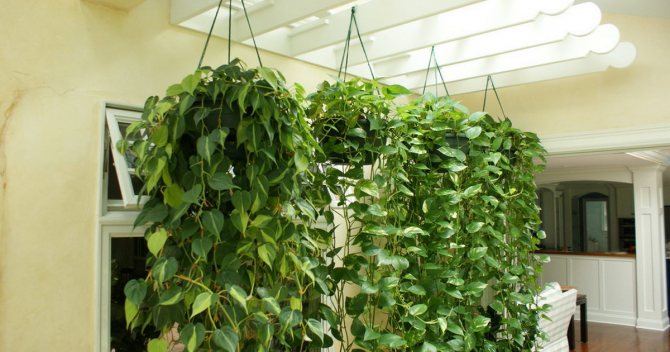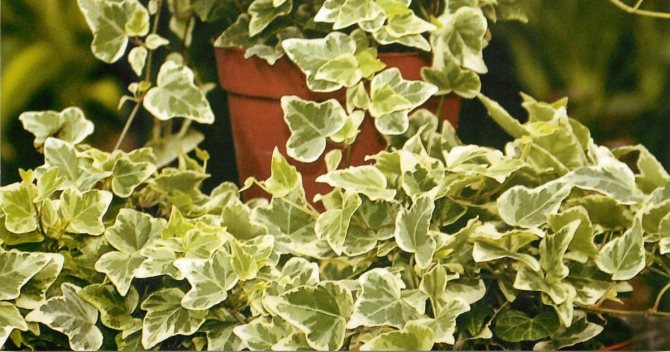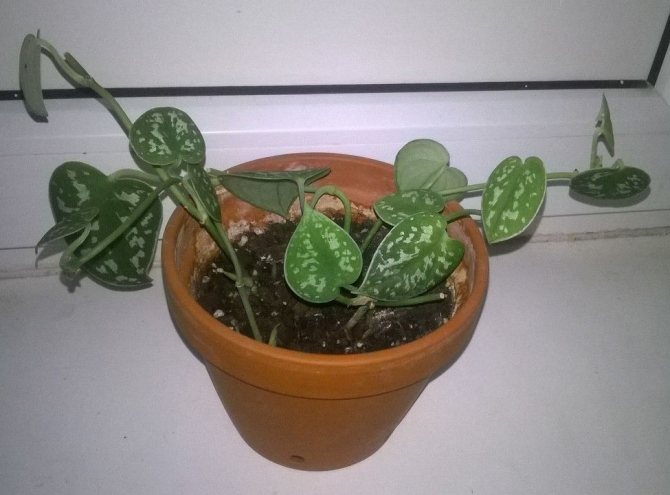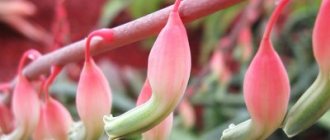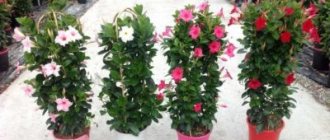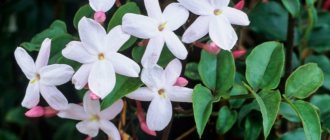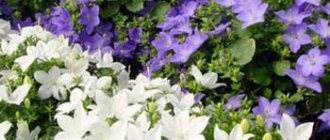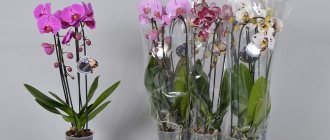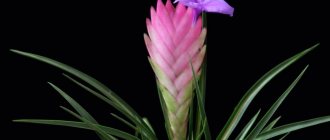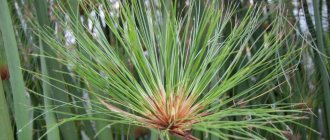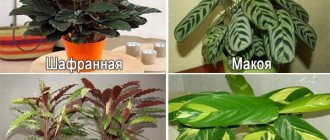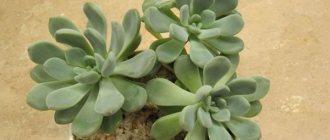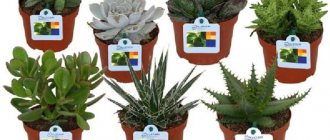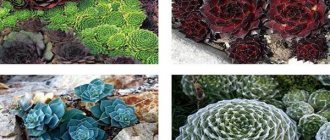Scindapsus is a prominent representative of the Aroid family. The genus includes about 25 species that can be found in the wild in Southeast Asia. These evergreen vines belong to epiphytic plants and can climb a tree to a height of 15 m. The name of the genus literally means "a tree that resembles ivy." You can find other names for the flower - golden potos, black ivy, muzhegon.
The plant has gained immense popularity due to its bright, dense and fast-growing deciduous part. Its unpretentiousness allows you to grow a flower in workrooms, warehouses, offices, shops, and some varieties become an excellent decoration for garden plots and facades of houses. Even a beginner can take care of an unusual liana at home, so even a novice florist can decorate his house with scindapsus, the decorativeness of which can be seen in the photo.
Types, photos and names of scindapsus
There are about 25 plant varieties around the world. Each of them winds up the trees and can be located on the ground. They differ from each other in color and shape of the leaves.
Some varieties presented in the collections of greenhouses and parks were first bred by breeders and exist in a single copy. At home, there are only six species that are safe for growing.
Scindapsus Pictus
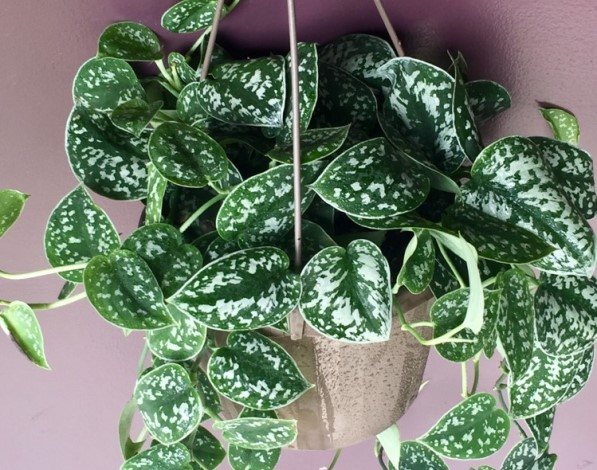
In nature, this liana grows, winding around tree trunks, and reaches a length of more than 2.5 meters. Most often found in tropical forests of Malaysia, Indonesia. Even in captivity, this species grows up to 1 meter. The size of the leaves ranges from 5 to 7 cm in width and 12-15 cm in length. Pictus has large, oval-shaped leaf plates, with a silvery-gray color. For the original color it was given an interesting name - Painted.
On a note! Scindapsus Trebi is the most common variety of this type. From the outside, you might think that he has small lizards instead of leaves.
Scindapsus Golden (Scindapsus Aureus)
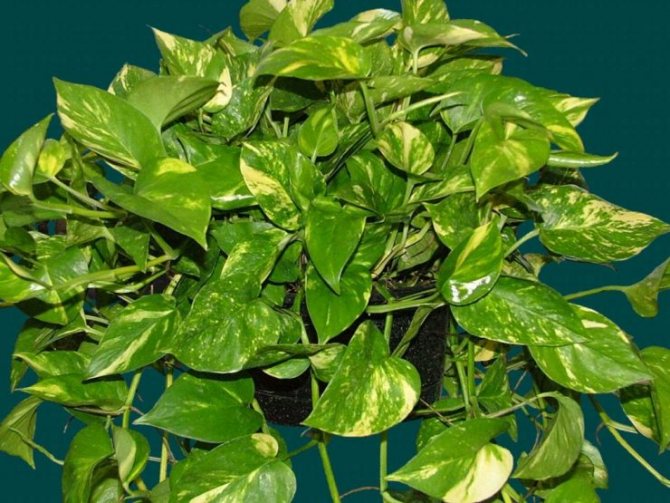

The golden look is also called Epipremnum aureum. In artificial growing conditions, the maximum liana length is up to 2 meters. Young plants have heart-shaped leaves, a monochromatic emerald green color, and later golden spots and stains appear. In bright light, it seems as if they shimmer.
Despite the fact that the vine does not require special skills in caring for it, this species is more susceptible to disease and pest attacks than others.
Interesting! For a kind of optical illusion in the United States, Scindapsus Aureus is called the "Golden Lotus".
Scindapsus N'Joy
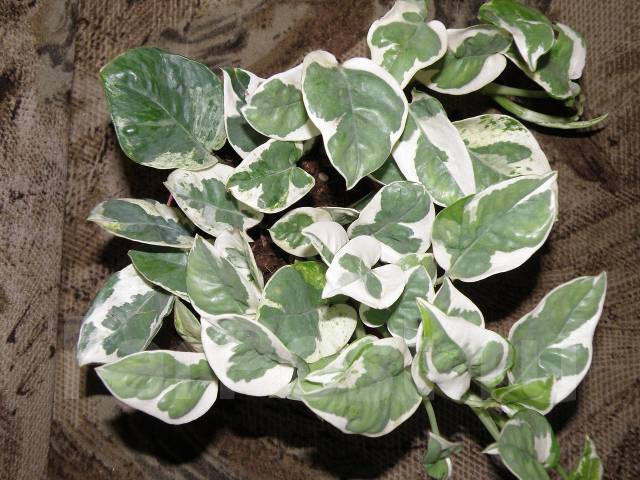

The Engoy variety is still found only in botanical gardens and greenhouses. Botanists recommend growing it in a hanging basket or in an aquarium, like many other vines.
Its main difference is compactness. The leaves are painted in a juicy lemon color, with silvery blotches. The first Scindapsus N-Joy was bred in Holland quite recently, but has already earned popularity among gardeners and botanists.
Scindapsus Neon
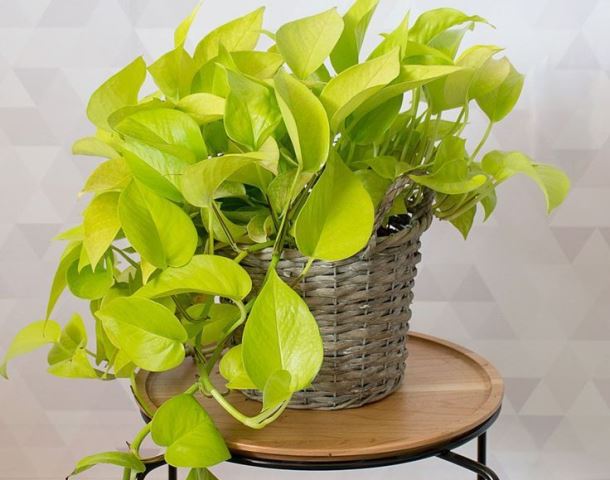

The second name is Epipremnum Golden Neon. The first thing that catches your eye is the medium-sized leaves, painted in a bright light green color.By the way, the stems practically merge with the leaves, which are attached to its inner side. This species grows very quickly, therefore it is necessary to prune it in time so that the vine looks neat.
Scindapsus Marble Queen
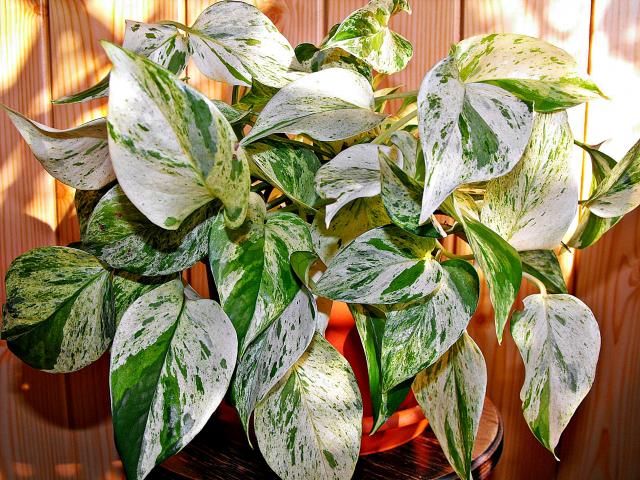

Marble Queen is a liana of delightful beauty. Variegated touches and strokes in silvery shades create a unique pattern on the plates. Sometimes it is not clear what color the leaves were: silvery or green. Due to this color, it seems as if the scindapsus is in constant motion.
On a note! Marble Queen, translated from English - Marble Queen. This name is fully justified by the color of the leaves.
Scindapsus Exotic


Scindapsus Exotic is a hybrid that appeared as a result of selection. He has an original plate shape - one side is larger than the other. Because of this, the central vein is slightly curved. If you touch the leaf, you can feel the protruding tubercles between the veins.
Scindapsus and Epipremnum: differences
There are differences between Scindapsus and Epipremnum, but they are almost invisible externally. They have almost the same biological characteristics, both belong to the Aroid family... Plants differ in two ways:
- The number of seeds in the inflorescence is different.
- In Scindapsus, aerial roots are formed only in the nodes, and in Epipremnum, along the entire length of the trunk.
Many species and varieties that previously belonged to scindapsus now belong to the epipremnum species. For example, Aureus (golden) is considered a species of "epipremnum scindapsus"... In fact, the names are used interchangeably and both are correct.
Scindapsus photo:
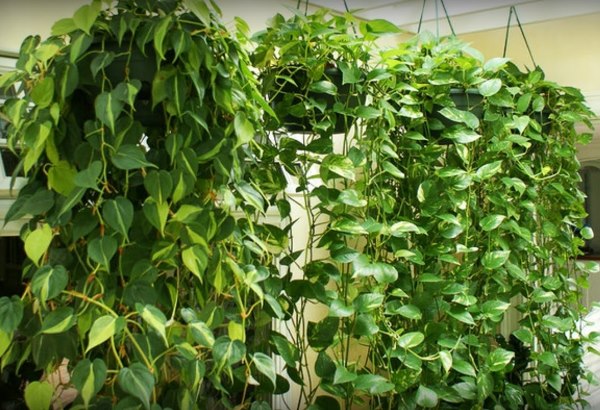

Description, origin
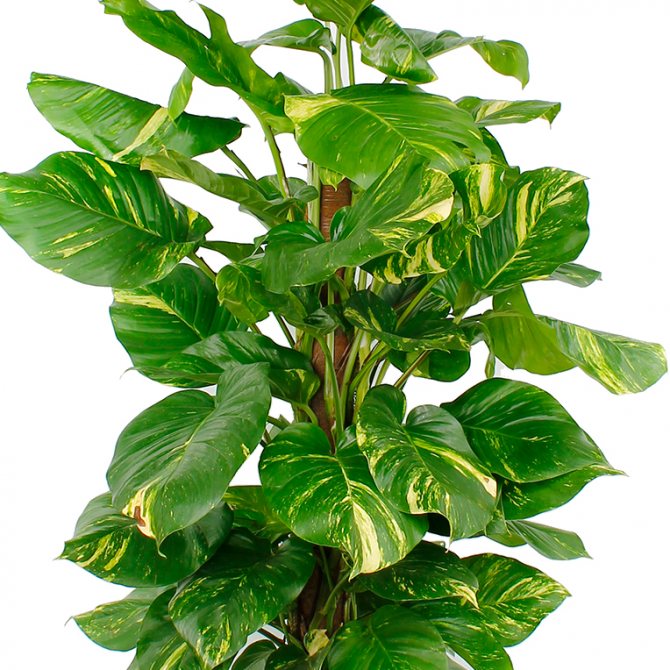

This flower is native to Southeast Asia and New Guinea, where the leaves of the climbing plant reach up to 100 cm. It belongs to the Araceae family, which has more than 100 varieties. Previously known scientifically as Scindapsus aureus or Phaphidophora aureu. It is still called Scindapsus aureus in most of Europe today. In America and Canada Epipremnum. Today, botanists call it Epipremnum aureum.
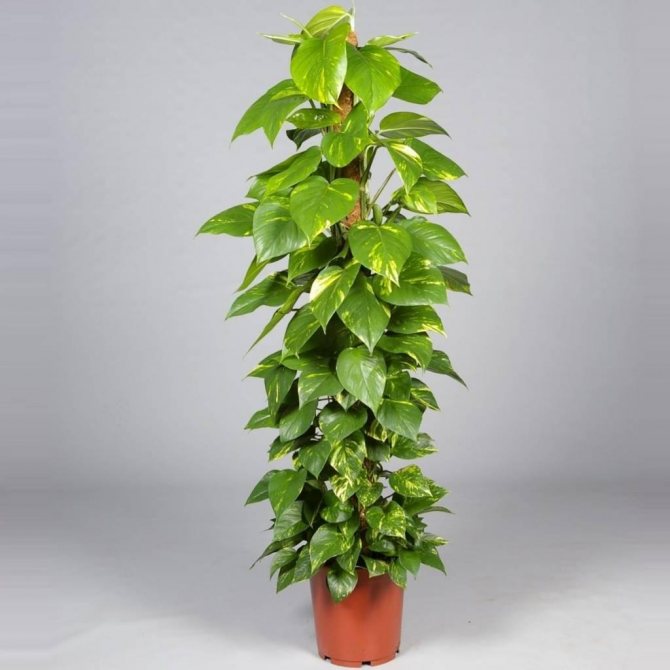

Care rules
Scindapsus is considered an unpretentious plant. But it still has some peculiarities in keeping it indoors.
Lighting
In natural conditions, variegated representatives of the culture prefer sunlight, but often take refuge under the crowns of trees. In order to avoid burns on the leaves, especially if the windows face the south side, the pot must be placed next to it, but avoid direct sunlight.
Temperature
The optimum air temperature in the room in which the liana grows is 18-20 degrees in the warm season. If the weather outside the window is minus 16 degrees. Scindapsus does not like it when it is near batteries or heaters... By the way, the plant tolerates high temperatures in summer and low temperatures in winter with dignity. But sharp temperature jumps and drafts should not be allowed.
Watch the video on how to properly care for the scindapsus
Watering and moisture
It is recommended to moisten the soil on hot summer days every other day. A young, actively growing plant requires abundant watering and a stable moist soil. As soon as the top layer of the earth dries up, it must be watered with warm, settled water.
The main thing is to prevent stagnation of liquid in the soil after watering, otherwise it will lead to decay of the roots and loss of the plant.... Drainage of the soil will help with this, using special coarse-grained materials and a pallet.
The first sign of over-watering is water droplets on the inside of the scindapsus plate. Since the liana needs a relatively high humidity, about 50-60% indoors, it is necessary to additionally spray it from a spray bottle and wipe the leaves with a damp cloth.Periodically, once a week and a half, you can water it in the shower.
Interesting! Folk omens and superstitions say that this plant gives a boost of energy. It is enough just to sit next to him for a while.
Top dressing
Any fertilizer for home flowers is suitable as a complementary food. Young vines are fed in summer and spring once every two weeks. More mature plants with relatively long stems require complementary foods once a month in winter. You can add it only after watering. Otherwise, there is a chance to burn the roots and destroy the plant.
Bush formation
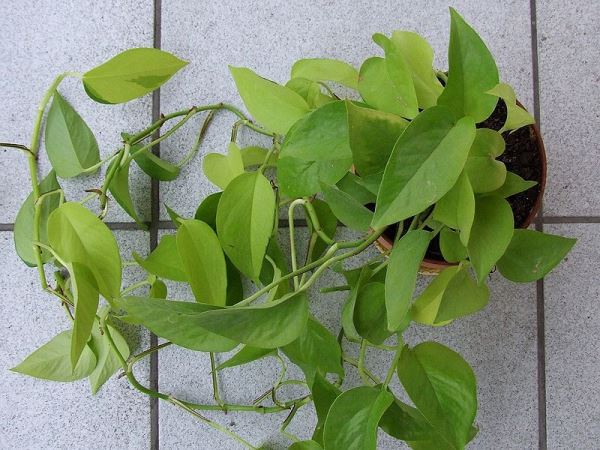

The vine grows about 40 centimeters annually. Therefore, in order for the scindapsus to always look neat, you need to form a bush. That is, regularly cut off unnecessary processes. If desired, you can use the trimmings to grow another scindapsus. They are also pinched to make the vine thicker and more branchy.
Usually, the crown of the bush is formed using specialized arched supports. If the vine has already grown, then plastic pipes with small holes are used... They are filled with moistened peat moss and coconut pulp, and air roots are inserted into the holes. This is necessary for the plant's constant access to moisture and nutrients.
Transfer
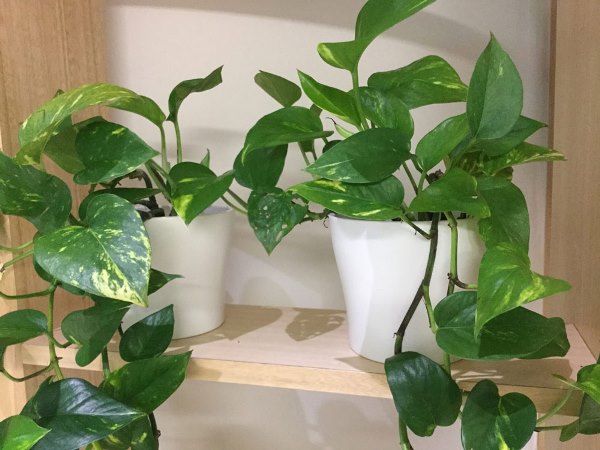

Young scindapsus are regularly transplanted once a year, grown up - once every 2-3 years. The best period for the procedure is from February to March. It is better to use a transplant pot low but wideso that you can plant cuttings in it (root and feed). To do this, you will need a transplant substrate, which includes:
- sand;
- peat soil;
- leafy soil;
- humus soil;
- expanded clay or perlite.
All "ingredients" are mixed in equal proportions. A dense layer of drainage is laid out on the bottom of the container. Immediately after transplanting, the plant is watered.
The soil
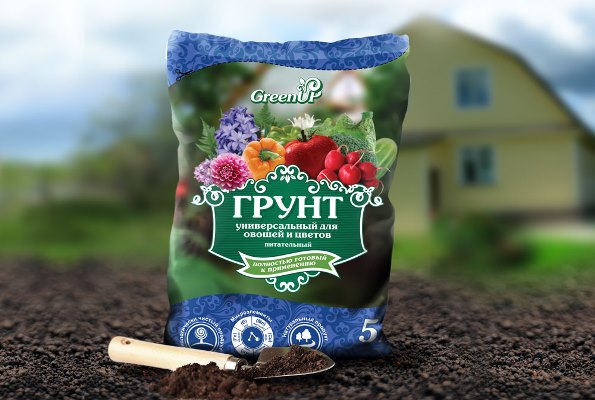

The soil for growing scindapsus is preferable to be loose, as light as possible with a slightly acidic reaction. A composition of the following components (in equal proportions) is ideal:
- peat;
- humus;
- sod soil.
River sand and ground pine bark are added as additional nutrients.
Lighting
Scindapsus belongs to shade-tolerant plants, but prefers bright diffused light. Variegated varieties especially need it. In the shade, the pattern on the foliage may disappear.
Scindapsus must be protected from direct sunlight from March to September... Otherwise, the leaves fade and fall off.
Epipremnum will feel good at a distance of 0.5-2 meters in front of a well-lit window. In winter, it is recommended to place it as close to the window as possible.
The plant develops normally under artificial lighting with fluorescent or phytolamps. In this case, both in winter and in summer, he needs to create a 10-hour daylight hours.
Loading ...
Reproduction of scindapsus
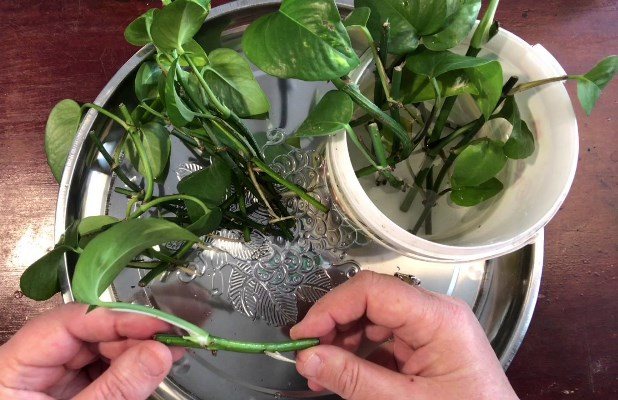

Vine propagation takes place with the help of cuttings and layering.
Propagation by cuttings
This method is suitable for cuttings that have been cut from the top of the crown. They are placed in water or immediately planted in a substrate. The first roots appear quickly. Basic recommendations for growing:
- There are 2-3 leaves on one handle.
- The temperature in the room where it is planned to grow new vines should be at least 22 degrees.
- Good lighting.
- In the process of preparation, the cuttings are cut at an angle, after which the cut site is treated with an agent to accelerate root growth. Then they are planted in the prepared soil mixture. Then cover with a plastic transparent bag or jar.
It is interesting! In the ancient Chinese science of Feng Shui, the shape of the leaves of the scindapsus is a symbol of pacification.
Reproduction by layering
Aerial roots on scindapsus shoots - an opportunity to grow a new plant with the help of cuttings.How to root: for this they take a long shoot and put it in another container with soil. Then sprinkle with earth and press with a wire pin. After rooting, the cuttings are cut off, and the pots are separated and each plant is looked after separately.
In this video you can watch everything for the care and reproduction of scindapsus
Diseases and pests
Like any other living creature, vines have their own diseases. They are also attacked by pests. How to deal with each ailment, read on.
- The leaves are blackened, wither. Reason: excess moisture, which leads to rotting of the roots. Solution: reduce the amount of water and the frequency of watering. When the vines die, cut off whole cuttings.
- Dry the edges of the leaves... Reasons: dry air in the room, heating devices nearby. How to treat: remove from the battery or heater, humidify the air.
- Leaves become brittle, fall off... Reasons: draft, insufficient feeding, poor lighting. Slight dropping is considered normal. It is worth "treating" only with a strong loss of leaves. What to do: eliminate the cause of the disease.
- The leaves have lost their brightness... Reason: not enough light. Solution: create good lighting conditions: put a phytolamp or move it to a brighter room.
- The leaves turned pale... Reason: an overabundance of sunlight. What to do: Move to a darker place.
- The tips of the plates are wrapped... Reason: salt in the soil. What needs to be done: transplant, watering with the help of settled water at room temperature.
- The distance between leaves has increased, the appearance has deteriorated... Probable reasons: a lot of complementary foods, high nitrogen content. Solution: reduce the frequency of fertilization.
- Does not grow... Reasons: soil depletion, cramped pot. What to do: Transplant into a large container with new soil.
- Mosaic stains... Reason: virus. Treating scindapsus for viruses will not work. The plant will die anyway, and the young shoots are already infected.
- Leaves turn yellow, but retain firmness... Why: lack of vitamins. Solution: feed the scindapsus.
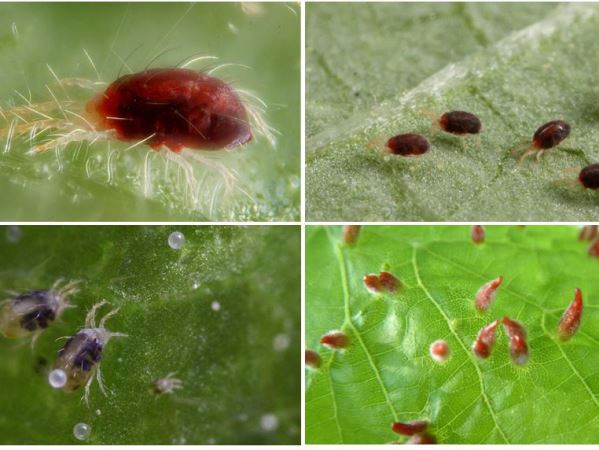

Insufficiently humidified air attracts pests. The most common is the spider mite. White, like fibers, plaque on the plates, internodes is the first sign of an uninvited guest. You can get rid of it with a folk remedy. It is enough to moisten a sponge in a solution of laundry soap and process the plant. If it does not help, then it is recommended to use chemicals once every ten days.
When the plant is attacked by aphids, treatment with products containing permethrin will help. Scabbards and thrips are disposed of by removing insects from the leaf with a cotton swab dipped in alcohol. As a last resort, resort to chemicals that will not harm the vine.

